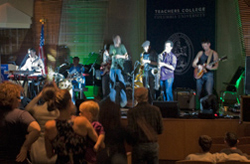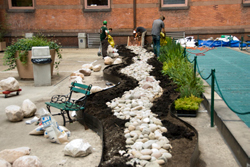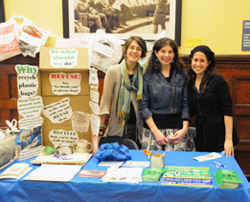Filed Under > TC Community
Toward a Greener TC
TC is in the midst of taking its commitment to safeguarding the environment to the next level, transforming what has been a loose configuration of programs into a coordinated effort at sustainability that has set clearly defined targets for the next several years.
The College is stepping up its environmental efforts
TC is in the midst of taking its commitment to safeguarding the environment to the next level, transforming what has been a loose configuration of programs into a coordinated effort at sustainability that has set clearly defined targets for the next several years. Chief among them is a plan to boost the rate of recycling at the College from 35 percent of all waste recycled to 50 percent over the next two years, and from 50 percent to 75 percent over the next five years.
Two years ago, TC President Susan Fuhrman made the determination that, to truly “go green,” the College needed to move beyond ad hoc efforts to identify the essential components of sustainability and how to implement and measure them. At Fuhrman’s behest, the TC Student Senate formed its Go Green Committee, with an executive steering committee that included Provost Tom James; Janice Robinson, Vice President for Community and Diversity; Jim Mitchell, Associate Vice President, Campus and Auxiliary Services, and several other key staff members. But even as the student arm of the Go Green Committee launched highly visible efforts such as the Rockin’ Earth Day Festival, the College was establishing a range of long-term initiatives.
“We’re beginning to see the fruits of that work now,” says Harvey Spector, Vice President for Finance and Administration. “Nevertheless, success will ultimately require each individual member of the TC community to make a personal commitment to safeguarding our environment.”
On the broadest level, the College has committed to three guiding principles that show commitment to sustainability:
• Demonstrating institutional practices that promote sustainability, including measures to increase efficiency and use of renewable resources, and to decrease production of waste and hazardous materials.
• Encouraging environmental inquiry and institutional learning throughout the College community.
• Establishing indicators for sustainability that will enable monitoring, reporting and continuous improvement.
The first steps have been to get a baseline for how effective current environmental initiatives have been, as well as to gauge the amount of the College’s solid waste that can be recycled, the opportunities for reducing or changing purchased items that currently end up in the trash, and ways to expand and improve upon current efforts.
To that end, the College contracted this past May, with Defeo and Associates to conduct an audit of its solid waste and recycling programs. The audit found that TC produces about 1,280 tons of solid waste per year, and collects approximately 401 tons of recyclable material and 877 tons of waste (trash) annually. Fiber—any material made from paper—represents 86 percent of the College’s total recycling stream.
To improve on that performance during the coming year, TC will introduce new procedures this year for staff in Horace Mann, Thompson and Russell Halls. The following year the new procedures will be implemented in Zankel, Macy, Grace Dodge and Thorndike. Each employee will be given a desk-side three-in-one collection container for recycling, and each suite or shared space will receive a recycling station with larger bins for their bigger office suites.
“To succeed, to get people to participate, we need to give them the tools and show them how,” says Mitchell. “Each person will be responsible for taking their desk-side can to empty it into the bigger bins. The custodians will still be responsible for emptying the shared units.”
Meanwhile, TC has identified other energy-and cost-saving opportunities. One centers on replacing traditional incandescent light bulbs with compact fluorescent bulbs. One 27-watt fluorescent light has the same light output as one 100-watt incandescent bulb, while lasting for 10,000 hours, versus just 750 hours for a fluorescent bulb. The lifespan of a 27-watt compact fluorescent bulb will save more than 1,000 pounds of carbon dioxide from being released into the atmosphere versus a 100 watt bulb.
The College will begin systematically replacing all lighting ballasts—the electric starters for lights in each light fixture—from T-12 magnetic ballasts to the much more energy-efficient T-8 electronic ballasts. Light sensors are also being installed in common spaces such as the refurbished Edward D. Mysak Clinic for Communication Disorders, to turn off lights when rooms are not in use.
There are also opportunities to conserve energy used for heat and air conditioning. For example, Mitchell says the College currently wastes a lot of heat through un-insulated pipes in Zankel basement. Insulating the pipes will prevent heat loss and allow more steam to run through the building, reducing the demand on TC’s boiler. The College also has a chiller plant capable of providing air conditioning to the whole campus. “Over time and through larger renovation projects we have the opportunity to capitalize on our excess capacity,” Mitchell says.
Another initiative focuses on revamping campus water fountains to help eliminate the use of bottle water on campus. The Office of Facilities Management is in the midst of a two-year retrofit/replacement project for all campus water fountains that will provide new filtered fountains with an extended faucet to enable filling of personal water bottles. (New York City tap water has been deemed among the highest-quality water in the world.) The work is already completed in Grace Dodge. Drinking bottled water contributes to the amount of carbon dioxide added to the atmosphere. Meanwhile, during the past four years, the College has been using water-saving washing machines in all residence halls, saving 1,762,000 gallons of water in residence hall laundry rooms.
To further advance the College’s sustainability efforts, Mitchell and his team are urging members of the TC community to adopt behaviors that promote energy savings and sustainability, including:
• Powering down computers and other office equipment upon leaving the office;
• Adhering to the College’s recycling procedures;
• Eliminating the use of bottle water in offices;
• Turning off lights in unused conference rooms, offices, classrooms and other spaces;
• Using recycled paper with at least 30 percent post-consumer content;
• Using duplex (two-sided) printing;
• Eliminating stand-alone fax and printer devices and switching to multifunction devices that copy, print and fax.
When it comes to supporting environmental inquiry and institutional learning throughout the College community, Mitchell credits the student Go Green committee with taking much of the lead. The Committee has conducted outreach programs such as Rockin’ Earth Day and Plastic Bag Collection. They’ve worked with the Rita Gold Center, the Hollingworth Science Camp and the EarthFriends Lab to provide curriculum opportunities for school-aged children. A centerpiece of those efforts has been the recently installed Rain Garden in Russell Courtyard, the grant for which was obtained from Brita by Colin Schumacher, a student in TC’s Elementary Inclusive Preservice Education Program. The College has also supported efforts in the courtyard by providing 16 planters for use with children and replanting other areas with indigenous year-round plants. Campus Dining has chipped in by providing the materials for two demonstration-purpose composting bins. Additionally, all of the landscaping planters in Russell Courtyard and along 120th Street now contain native perennial plants, which reduce the carbon footprint associated with procuring annual flowers. Native plants become increasingly drought-tolerant over time. The plant displays are striking reminders of the importance of ecological diversity.
In all, Mitchell says, TC has “created this commitment and has institutional momentum. The next step is to engage people on an entirely different level. When they understand that the College has made that commitment, we’re pretty sure they’ll sign on.”
Published Monday, Dec. 13, 2010


